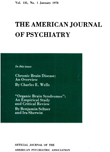AN EVALUATION OF INTRAVENOUS ETHER AS A TREATMENT FOR PSYCHIATRIC PATIENTS
Abstract
1. Seventy-three committed patients diagnosed as having affective psychoses were divided at random into 3 treatment groups: one group received intravenous ether, one group intravenous saline, and a third group electric shock treatment.
2. Of the 37 patients who received intravenous ether 37.8% were scored as "improved"; 52.9% of the 17 patients who received intravenous saline were scored as "improved"; and 89.4% of the 19 patients who received electric shock treatment were so scored. A comparison of the results obtained following intravenous ether and intravenous saline showed statistically no significant difference. The improvement following electric shock treatment was significantly higher than that obtained following either intravenous ether or intravenous saline.
3. Twenty-two of the patients who failed to improve with intravenous ether were then given electric shock treatment, and 19 of these improved sufficiently to leave the hospital; 7 of the patients who failed to improve with intravenous saline were then given electric shock treatment and all 7 improved sufficiently to leave the hospital. A comparison of the results obtained by electric shock treatment alone with those obtained by a combination of ether and electric shock or saline and electric shock showed no differences considered significant by statistical methods.
4. Autonomic nervous system tests(6) showed that patients whose autonomic reaction was classified as "favorable" as far as electric shock treatment was concerned showed a higher rate of improvement with ether than did patients whose autonomic reaction would indicate a poor prognosis with electric shock treatment. However, the improvement rate in the "favorable" autonomic group cases was poor as compared with the expected improvement rate of similar cases treated with electric shock treatment.
5. It is concluded that intravenous ether as a treatment for affective psychoses showed no specific treatment effect that could not be obtained by intravenous saline, and that electric shock treatment was a much more efficacious treatment than ether in such cases.
Access content
To read the fulltext, please use one of the options below to sign in or purchase access.- Personal login
- Institutional Login
- Sign in via OpenAthens
- Register for access
-
Please login/register if you wish to pair your device and check access availability.
Not a subscriber?
PsychiatryOnline subscription options offer access to the DSM-5 library, books, journals, CME, and patient resources. This all-in-one virtual library provides psychiatrists and mental health professionals with key resources for diagnosis, treatment, research, and professional development.
Need more help? PsychiatryOnline Customer Service may be reached by emailing [email protected] or by calling 800-368-5777 (in the U.S.) or 703-907-7322 (outside the U.S.).



